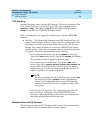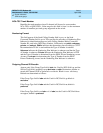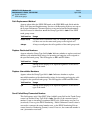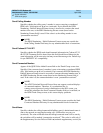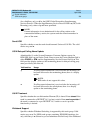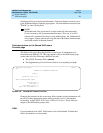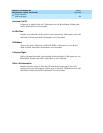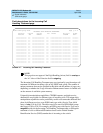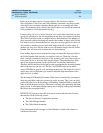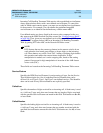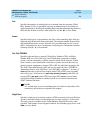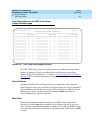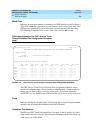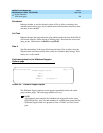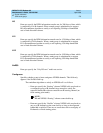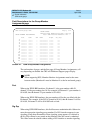
DEFINITY ECS Release 8.2
Administrator’s Guide
555-233-506
Issue 1
April 2000
Screen reference
764ISDN trunk group
17
Each row in the table consists of seven columns. The first three columns
(Service/Feature, Called Len, and Called Number) constitute a key that together
select which row or unique treatment should apply for an incoming call on the
group. The remaining four columns (Del, Insert, and so on) specify the treatment
to be provided for a call that matches the key.
If an incoming call is for a service listed in a row on the table, then that row may
specify the treatment for the call, depending on the other two columns of the key.
The Called Len field is used to continue the row determination. If the number of
digits received with the incoming call matches the number of digits in the Called
Len field for calls to the matched service, then this row may apply. If no other row
also contains a matching service and called length, then this row does apply. If
another row does exist with the same service and number length, then the Called
Number field will be used to continue the row determination.
If the leading digits received with the incoming call match the digits specified in
the Called Number field, then this row applies to the call. Therefore, with this
table, a unique treatment can be given to any incoming call, even if these calls are
to the same service or have the same length of digits. The remaining four fields
specify the unique treatment for the call once the row has been determined.
Together, the Del and Insert fields can be used to manipulate the incoming number
that will be used to route the call. The Per Call CPN/BN field can be used to
request CPN/BN for specific calls incoming on the group. The Night Serv field is
used to have calls of different types routed to different night destinations when
night service is in effect.
The Incoming Call Handling Treatment Table always automatically rearranges to
show the precedence order the system uses to pick an entry. Thus, you can easily
predict the behavior of the Incoming Call Handling Treatment Table by noting the
order in which the entries display. (The entries rearrange after submitting the trunk
group screen. A subsequent change trunk-group or display trunk-group command
then shows the rearranged order.)
DEFINITY ECS traverses the table from top to bottom and picks the first entry
that matches all the following criteria:
■ The Service /Feature, if applicable, matches
■ The Called/Length matches
■ The Called Number matches
If the administered Called Length or Called Number is blank, that criterion is
considered successful.



